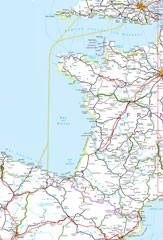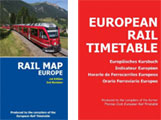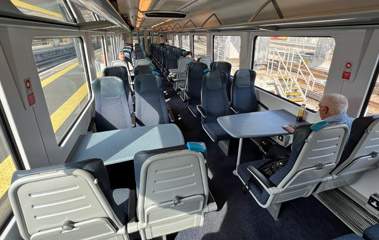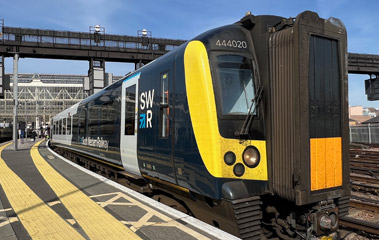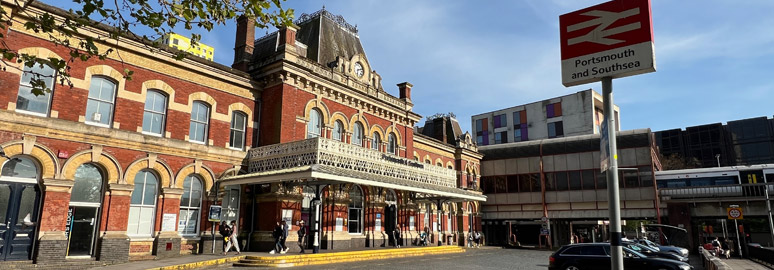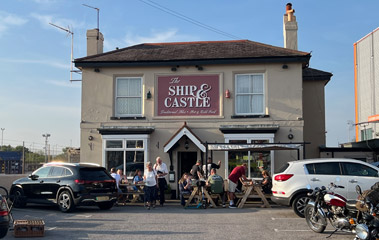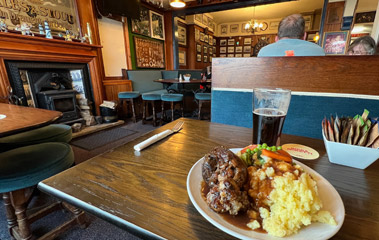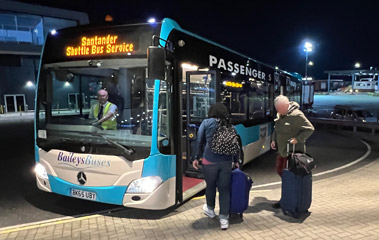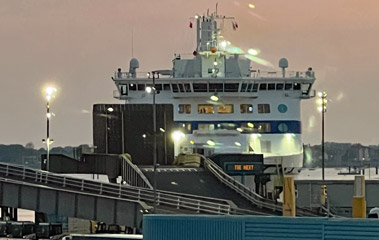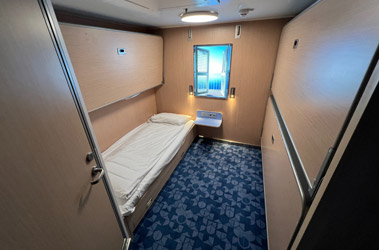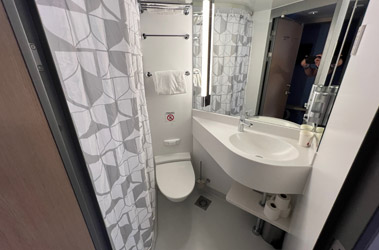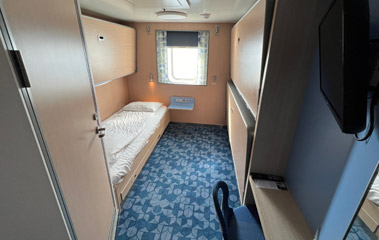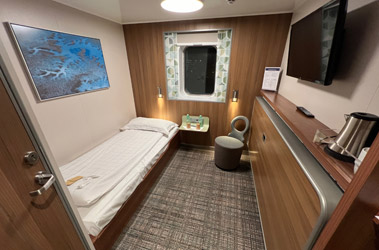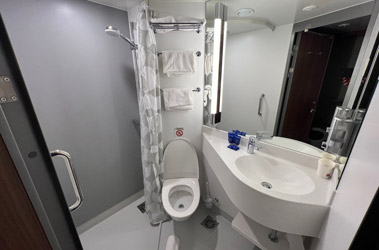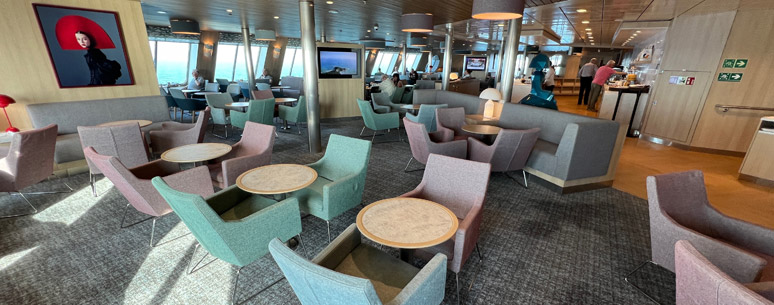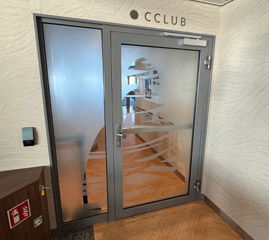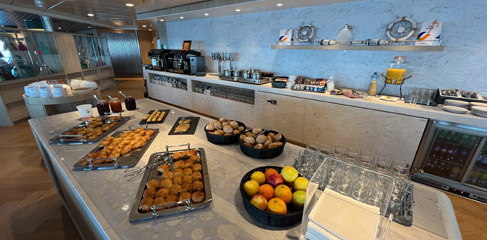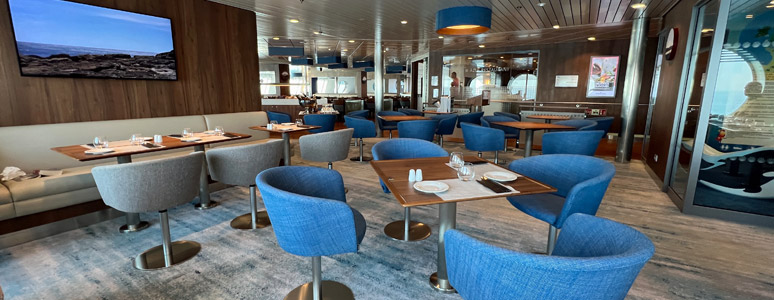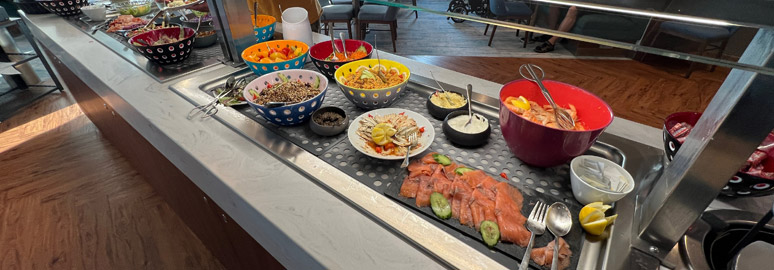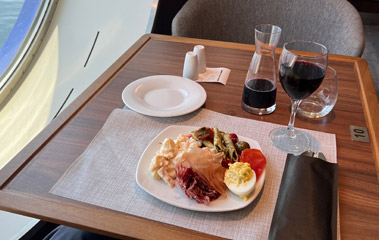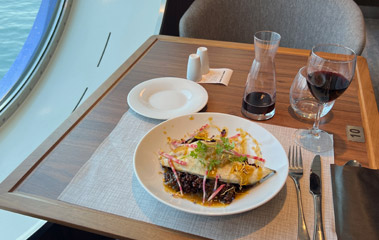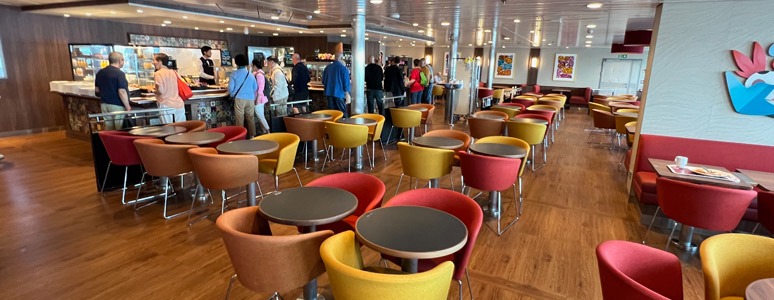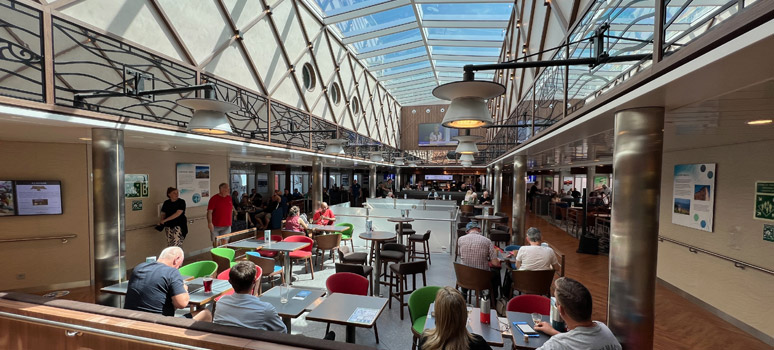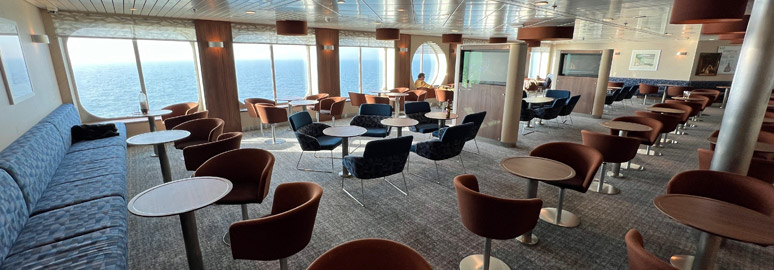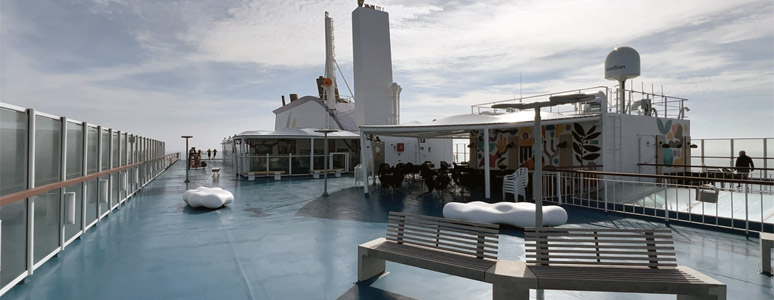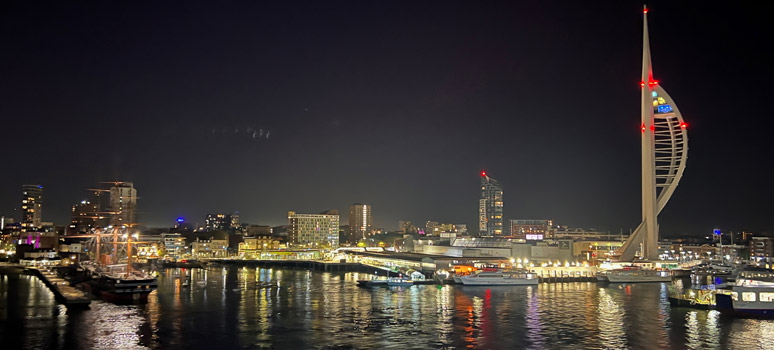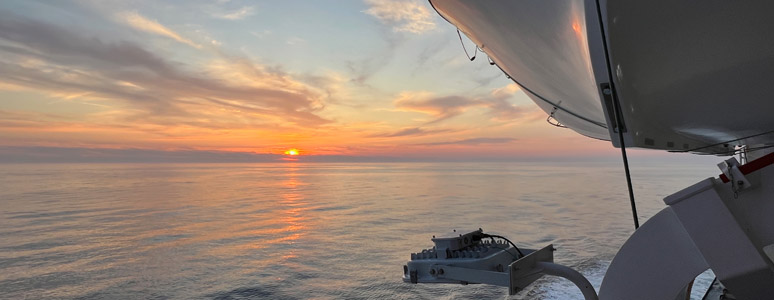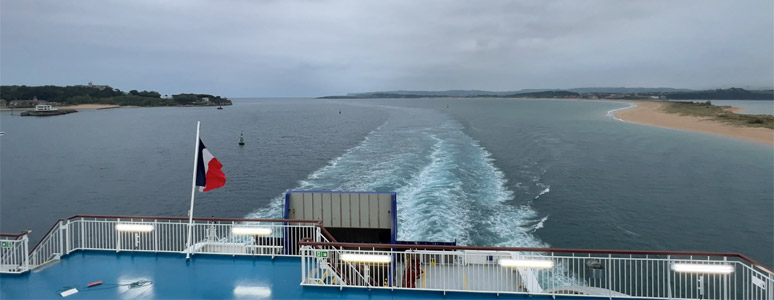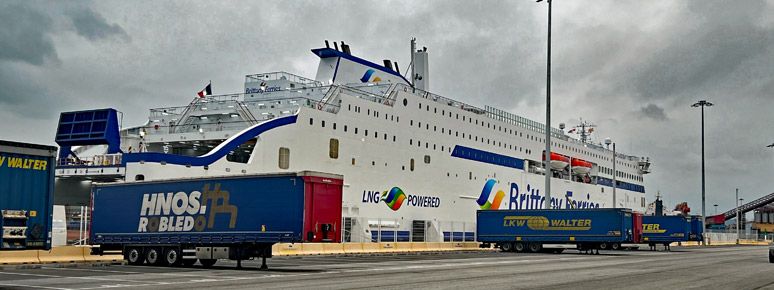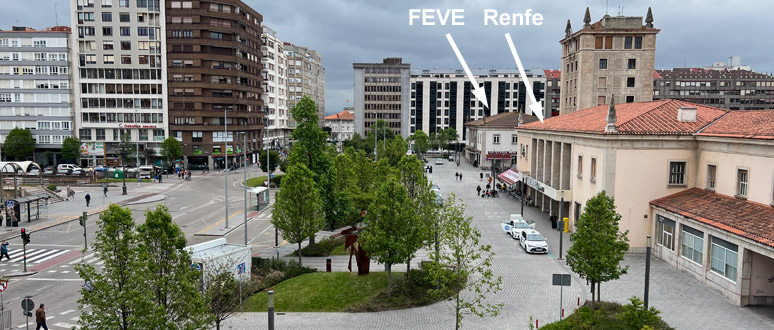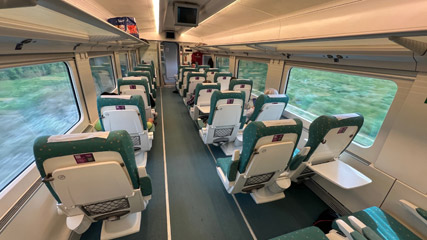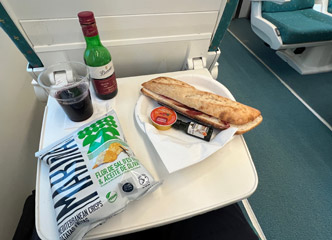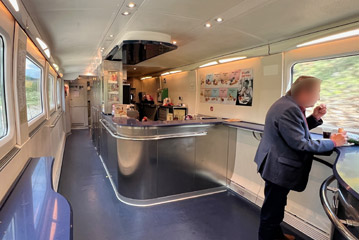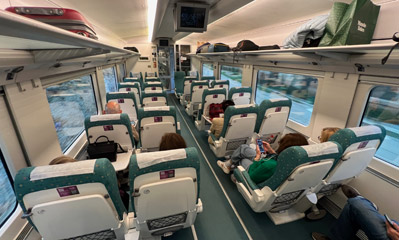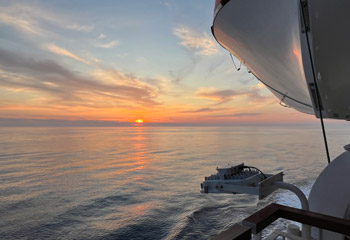 |
|
|
Sailing to Spain, watching for dolphins as the sun sets. |
|
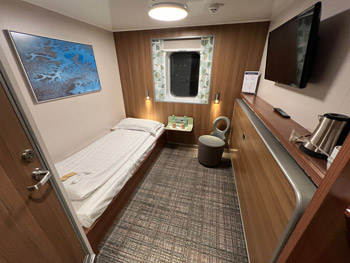 |
|
|
Club cabin on the Santoña. At Santander, it's just a 6 minute walk to the station for a fast Alvia train to Madrid. |
Sail to Spain with www.brittany-ferries.co.uk
You can take the train to Spain, or you can sail there from the UK on a luxurious ferry that's more liner than traditional Channel ferry. Brittany Ferries now operates an unprecedented 5 sailings a week direct to Spain for much of the year on 3 routes. Portsmouth to Santander or Bilbao takes just 2 nights, 1 day. You can take your car, but on this page I'll explain how to travel as a foot passenger with train connections.
![]() Video: London
to Madrid
via Brittany Ferries
Video: London
to Madrid
via Brittany Ferries
![]() On other pages: UK to Spain by
train
On other pages: UK to Spain by
train
Which ferry route to choose?
-
Portsmouth to Santander
This is the ideal route for train+ferry travellers (unless you find it easier to reach Plymouth), because the ferry-to-train arrangements in Santander are so easy.
Santander is a pleasant seaside town, the ferry terminal is right in the city centre just 6 minutes walk from the station for a fast train to Madrid or narrow-gauge train to Bilbao or Oviedo.
The Salamanca & Santoña operate this route twice a week all year taking 2 nights, 1 day. Check sailing dates & book at www.brittany-ferries.co.uk. See details of the train+ferry journey.
-
Portsmouth to Bilbao
Bilbao is a larger and more industrial centre than Santander, but on the other hand it's home to the famous Guggenheim Museum of modern art, well worth a visit.
In Bilbao the ferry terminal in a suburb, you have to take a Brittany Ferries shuttle bus (or taxi then metro) into the city before boarding a fast train to Madrid. So not as easy as Santander. However, Bilbao is well-connected, with direct trains to San Sebastian & Barcelona as well as Madrid.
The Salamanca, Santoña & Galicia operate this route twice a week all year, taking 2 nights, 1 day. Check sailing dates & book at www.brittany-ferries.co.uk. See details of the train+ferry journey.
-
Plymouth to Santander is the route to use if you live in the West Country.
The superb Pont Aven operates this route, once or twice a week from April to November. The Pont Aven is older but arguably the finest ferry serving the British Isles, with a wide range of facilities including prestigious Commodore Class cabins with satellite TV and private balcony.
Check sailing dates & book at www.brittany-ferries.co.uk. See details of the train+ferry journey.
-
About travel as a foot passenger
The ferries to Spain carry motorists, cyclists, freight and foot passengers. Most sailings carry foot passengers with a full range of cabins available. In this case, no problem, go ahead and book!
Some sailings carry foot passengers, but departures show cabins 'sold out' - only reclining seats seem to be available. Now re-run the enquiry with Car selected rather than On foot - Aha, cabins magically appear, they are clearly not sold out at all! In my opinion, foot passengers' money should be just as good as motorists. However, see my tip on checking for cancellations in the travel tips section.
A few sailings may not carry foot passengers. You'll see foot passenger option missing (or the sailing dates missing) when booking online. You can try an alternative route or date, or you can try calling Brittany Ferries to see if a foot passenger place can be booked by phone.
London ► Spain
Portsmouth ► Santander
-
Step 1, travel from London to Portsmouth by train
Trains run from London Waterloo to Portsmouth & Southsea twice an hour taking 1h30.
Look up ferry times first, then use a website such as tfw.wales or www.thetrainline.com to check train times & fares. You should leave London Waterloo at least 4h before the ferry sailing time, for example at 15:00 for a 19:00 sailing or at 19:30 for a 23:59 sailing.
There are also direct trains from Cardiff, Bristol, Brighton, Southampton and Reading to Portsmouth & Southsea.
No reservation necessary on the trains, you can buy a ticket on the day if you like. However, there may be cheap advance fares if you pre-book and commit to a specific departure. Get off at Portsmouth & Southsea station for Portsmouth International Ferry Port, not Portsmouth Harbour.
A taxi from Portsmouth & Southsea station to the International Ferry Port costs around £7 or it's a 26-minute 1.1 mile walk, see walking map.
There's a 45 minute minimum check-in for the ferry, but always allow plenty of time in case of delay. There are cafes upstairs at the Ferry Port, but I recommend a 5 minute walk round the corner to the friendly Ship & Castle for a pint and perhaps some food, see walking map.
-
Step 2, sail from Portsmouth to Santander by ferry
Brittany Ferries sails from Portsmouth to Santander twice a week for most of the year, leaving Portsmouth on Monday & Friday evenings arriving Santander at 08:00 two nights later. Sailing days & times vary so check at www.brittany-ferries.co.uk.
The ships on this run are the modern 40,000 ton Salamanca and Santoña, all powered by LNG. All cabins have shower & toilet, there are restaurants, bars, children's play areas, sun deck, cafe, shops, cinema.
Enjoy the departure from Portsmouth International Ferry Port as the ship sails right past Portsmouth's historic naval dockyard with Nelson's flagship HMS Victory and then Victorian ironclad HMS Warrior clearly visible from the ferry, as well as Portsmouth's new 'Spinnaker Tower'.
-
Step 3, travel from Santander by train
In Santander, the ferry arrives at the Estación Maritima right in the city centre, an easy 6 minute (450m) walk from the Renfe mainline station and the FEVE narrow-gauge station, see walking map. Map of Santander showing ferry terminal & stations.
I recommend allowing several hours between the ship's arrival and an onward train to allow for any delay to the ship.
For Madrid, An Alvia train leaves Santander at 14:35, change at Valladolid, arriving Madrid Chamartin 18:55. Or there's a direct Alvia train leaving Santander at 19:00, arriving Madrid Chamartin 23:07.
Or stay overnight in Santander, I recommend the Hotel Bahia just across the road from the ferry terminal and 6 minutes walk from the station. On Mondays-Saturdays the 07:05 Alvia train from Santander arrives Madrid Chamartin 11:19.
Check train times & buy tickets at www.thetrainline.com (easiest to use, small booking fee) or www.renfe.com (in €, much more fiddly).
Book these trains in advance as reservation is compulsory and there are cheap advance-purchase fares from around €28. Spanish high-speed trains can sell out so don't leave it to the last minute. Booking should open 60 days ahead, but often less.
For Alicante, stay overnight in Santander, I recommend the Hotel Bahia. On Mondays-Saturdays the 07:05 Alvia train from Santander goes direct to Alicante, arriving 14:43. Check train times & buy tickets at www.thetrainline.com or www.renfe.com.
For Bilbao, Oviedo or Gijon, take a narrow gauge local train formerly run by FEVE, now part of Renfe. The narrow-gauge station is next to the Renfe standard-gauge station and local trains run several times a day to Bilbao and to Oviedo with connections for Gijon. These routes are now bookable on the main journey planner at www.renfe.com, or try horarios.ram.renfe.com/...HorariosFeve.jsp.
For Barcelona, Seville, Malaga: Travel to Madrid Chamartin as shown above and transfer to Madrid Atocha by local train. Stay overnight in Madrid, see suggested hotels near Atocha. Then take a train from Madrid Atocha to Barcelona, Seville, Malaga or anywhere else in southern Spain. Check train times & buy tickets at www.thetrainline.com (easiest to use, small booking fee) or www.renfe.com (in €, much more fiddly).
Luggage storage in Santander: There are no luggage lockers at the station, use the lockers on the lowest level of Santander bus station.
Portsmouth ► Bilbao
-
Step 1, travel to Portsmouth by train
Trains run from London Waterloo to Portsmouth & Southsea twice an hour taking 1h30.
Look up ferry times first, then use a train operator website such as tfw.wales or www.thetrainline.com to check train times & fares. You'll need to leave London Waterloo around 4h before the ferry sailing time, for example at 18:00 for a 21:45 sailing or at 18:30 for a 22:30 sailing.
There are also direct trains from Cardiff, Bristol, Brighton, Southampton and Reading to Portsmouth.
No reservation necessary on the trains, you can buy a ticket on the day if you like. However, there may be cheap advance fares if you pre-book and commit to a specific departure. Get off at Portsmouth & Southsea station for Portsmouth International Ferry Port, not Portsmouth Harbour.
A taxi from Portsmouth & Southsea station to the International Ferry Port costs around £7 or it's a 26-minute 1.1 mile walk, see walking map.
There's a 45 minute minimum check-in for the ferry, but always allow plenty of time in case of delay. There are cafes at the Ferry Port, but I recommend a 5 minute walk round the corner to the friendly Ship & Castle for a pint and perhaps some food, see walking map.
-
Step 2, sail from Portsmouth to Bilbao by ferry
The Portsmouth- Bilbao ferry operates twice a week from late March to early November, usually leaving Portsmouth in the evening on Thursdays & Sundays, arriving Bilbao at 08:00 two nights later. Sailing days & times vary so check at www.brittany-ferries.co.uk.
Sailings on this route are operated by the 40,000 ton Salamanca, Santoña & Galicia, all powered by LNG. All cabins have shower & toilet, there are restaurants, bars, children's play areas, sun deck, cafe, shops, cinema.
Enjoy the departure from Portsmouth International Ferry Port as the ship sails right past Portsmouth's historic naval dockyard with Nelson's flagship HMS Victory and then Victorian ironclad HMS Warrior clearly visible from the ferry, as well as Portsmouth's new 'Spinnaker Tower'.
-
Transfer from the ferry terminal to Bilbao
The ferry docks in a suburb called Zierbena, 16 km northwest of central Bilbao, see map showing ferry terminal & stations.
Brittany Ferries run a free shuttle bus from the ferry to the terminal building then from the terminal building to a drop-off point behind the Guggenheim in central Bilbao, check www.brittany-ferries.co.uk and look under By bus on the Bilbao port page.
Alternatively, staff in the ferry terminal can call you a taxi. Take the taxi 5 km to Santurtzi metro station for around €20. Then take the metro from Santurtzi to Bilbao Abando station in the city centre, trains run every few minutes taking 27 minutes and cost just a couple of euros, see www.metrobilbao.eus.
-
Step 3, travel from Bilbao to Madrid, San Sebastian, Barcelona by train
For Madrid, an Alvia train leaves Bilbao Abando at 17:35 daily except Saturdays, arriving Madrid Chamartin 22:10.
Or stay overnight in Bilbao: An Alvia train leaves Bilbao Abando at 07:00 daily except Sundays, arriving Madrid Chamartin 11:28.
Check times and buy tickets at www.thetrainline.com (easiest to use, small booking fee) or www.renfe.com (in €, more fiddly).
For Barcelona, an air-conditioned Alvia train leaves Bilbao Abando at 14:11 weekdays, 15:20 weekends, arriving Barcelona Sants 22:20.
Check times and buy tickets at www.thetrainline.com (easiest to use, small booking fee) or www.renfe.com (in €, more fiddly).
For San Sebastian, Bilbao's Matiko station has hourly narrow gauge trains to San Sebastian (Donostia-Amara) run by Euskotren, journey time 2h35, check train times & fares at www.euskotren.eus. No need to book, just turn up, buy a ticket and hop on the next train.
Plymouth ► Santander
-
Step 1, travel to Plymouth by train
Check train times to Plymouth at tfw.wales or www.thetrainline.com.
In Plymouth, the ferry terminal is a 31-minute 1.4 mile walk from the station (see walking route) or take a taxi.
There's a 45 minute minimum check in for the ferry, but allow a couple of hours, never cut things fine.
-
Step 2, sail from Plymouth to Santander by ferry
This route operates from mid-March to early November, once or twice a week, sailing in the afternoon and arriving the following afternoon. Sailing days & times vary so check at www.brittany-ferries.co.uk.
This route is operated by Brittany Ferries' lovely Pont Aven, all cabins have shower & toilet, there are restaurants, bars, children's play areas, sun deck, cafe, shops, cinema.
-
Step 3, travel from Santander to Madrid by train
In Santander, the ferry arrives at the Estación Maritima right in the city centre, an easy 6 minute (450m) walk from the Renfe mainline station and the FEVE narrow-gauge station, see walking map. Map of Santander showing ferry terminal & stations.
I recommend allowing several hours between the ship's arrival and an onward train to allow for any delay to the ship.
An Alvia train leaves Santander at 19:00, arriving Madrid Chamartin at 23:07.
Or stay overnight in Santander, I recommend the Hotel Bahia just across the road from the ferry terminal and 6 minutes walk from the station. Next morning, the 07:05 Alvia train from Santander arrives Madrid Chamartin 11:19 & Alicante 14:43.
Check train times & buy tickets at www.thetrainline.com (easiest to use, small booking fee) or www.renfe.com (in €, much more fiddly).
Book these trains in advance as reservation is compulsory and there are cheap advance-purchase fares from around €28. Spanish high-speed trains can sell out so don't leave it to the last minute. Booking should open 60 days ahead, but often less.
For Alicante, stay overnight in Santander, I recommend the Hotel Bahia. The 07:05 Alvia train from Santander goes direct to Alicante, arriving 14:43. Check train times & buy tickets at www.thetrainline.com or www.renfe.com.
For Bilbao, Oviedo or Gijon, take a narrow gauge local train formerly run by FEVE, now part of Renfe. The narrow-gauge station is next to the Renfe standard-gauge station and local trains run several times a day to Bilbao and to Oviedo with connections for Gijon. These routes may soon become searchable on the main journey planner at www.renfe.com, but at the time I write this you need to use this hidden page to check train times: horarios.ram.renfe.com/...HorariosFeve.jsp.
Spain ► London
Santander ► Portsmouth
-
Step 1, travel to Santander by train
Check ferry times and sailing dates first, at www.brittany-ferries.co.uk. The ferry sails at lunchtime, too early for safe same-day connections from Madrid, so you need to travel the day before:
From Madrid, An Alvia train leaves Madrid Chamartin at 13:40, arriving Santander 17:47. Another leaves Madrid Chamartin at 19:08, arriving Santander 23:12.
Times may vary, check times & buy tickets at www.thetrainline.com (easiest to use, small booking fee) or www.renfe.com (in €, more fiddly).
Stay overnight in Santander, I recommend the Hotel Bahia, 6 minutes walk from the station and just across the road from the ferry terminal. Map of Santander showing station, hotel & ferry terminal.
From Alicante, an Alvia train leaves Alicante at 10:26 arriving Santander 17:47, then stay overnight in Santander. Times may vary, check times & buy tickets at www.thetrainline.com or www.renfe.com.
From Bilbao, Oviedo or Gijon, take a narrow gauge local train to Santander, formerly run by FEVE, now absorbed into Renfe. In Santander, the narrow-gauge station is next to the Renfe standard-gauge station. These routes are now bookable at www.renfe.com, or try horarios.ram.renfe.com/...HorariosFeve.jsp. A same day connection may or may not be possible, never cut it fine when catching a ferry.
From Barcelona, Seville, Malaga: Take a train to Madrid Atocha and transfer to Madrid Chamartin by local train, I'd allow at least 2h between trains in Madrid. Then travel from Madrid Chamartin to Santander as shown above. Check train times & buy tickets at www.thetrainline.com (easiest to use, small booking fee) or www.renfe.com (in €, more fiddly).
-
Step 2, sail from Santander to Portsmouth by ferry
Brittany Ferries sails from Santander to Portsmouth all year round, usually twice a week leaving Santander at lunchtime on Wednesdays & Sundays, arriving Portsmouth in the evening next day. Sailing days & times vary so check at www.brittany-ferries.co.uk.
The ships on are the modern 40,000 ton Salamanca and Santoña. All cabins have shower & toilet, there are restaurants, bars, children's play areas, sun deck, cafe, shops, cinema.
Make sure you're on deck for the arrival into Portsmouth, past the Spinnaker Tower and naval dockyard, past HMS Warrior & HMS Victory.
-
Step 3, travel from Portsmouth to London by train
A taxi from Portsmouth International Ferry Port to Portsmouth & Southsea costs around £7 or it's a 26-minute 1.1 mile walk, see walking map.
Trains link Portsmouth & Southsea with London Waterloo twice an hour taking 1h30. Buy a ticket on the day and hop on the next train.
There are also direct trains from Portsmouth & Southsea to Brighton, Salisbury, Bath, Bristol & Cardiff.
Check times using a train operator website such as tfw.wales or www.thetrainline.com.
Bilbao ► Portsmouth
-
Step 1, travel from Madrid, Barcelona or San Sebastian to Bilbao by train
From Madrid: On days when the ferry sails in the evening, leave Madrid Chamartin 07:05, arriving Bilbao Abando 11:47. On days when the ferry sails at lunchtime, leave Madrid Chamartin at 17:38 the evening before arriving Bilbao Abando at 22:21 and stay overnight in Bilbao.
Times may vary, check times & buy tickets at www.thetrainline.com (easiest to use, small booking fee) or www.renfe.com (in €, more fiddly).
From Barcelona, an Alvia train leaves Barcelona Sants at 08:38 arriving Bilbao Abando 15:36. On days when the ferry sails in the evening, a same-day conne3ction is possible. When the ferry sails at lunchtime, travel the day before and stay overnight in Bilbao.
Times may vary, check times & buy tickets at www.thetrainline.com (easiest to use, small booking fee) or www.renfe.com (in €, more fiddly).
From San Sebastian, take an hourly narrow gauge train from San Sebastian's Donostia-Amara station to Bilbao's Matiko station. The line is run by Euskotren, journey time 2h35, check train times & fares at www.euskotren.eus. No need to book, just turn up, buy a ticket and hop on the next train. A same-day connection is possible for all sailings.
-
Transfer from Bilbao city centre to Bilbao ferry terminal
The ferry terminal is in a suburb called Zierbena, 16 km northwest of central Bilbao, see map showing ferry terminal & stations.
Brittany Ferries run a free shuttle bus from Bilbao to the ferry terminal, it leaves from a pick-up point behind the Guggenheim in central Bilbao. Check details carefully with www.brittany-ferries.co.uk, look under By bus on the Bilbao port page.
Alternatively, take a metro train from Bilbao Abando station in the city centre to Santurtzi metro station, these run every few minutes taking 27 minutes, it costs only a couple of euros, see www.metrobilbao.eus. Walk from Santurtzi station to the tourist information centre (3 minutes, see walking map), and ask them to call you a taxi. Take the taxi from Santurtzi tourist information centre 5 km to the ferry terminal at Zierbena for around €20.
-
Step 2, sail from Bilbao to Portsmouth by ferry
Brittany Ferries sails from Bilbao to Portsmouth all year round, usually twice a week leaving Bilbao at lunchtime on Tuesdays or Saturdays, arriving Portsmouth early evening next day. Sailing days & times vary so check at www.brittany-ferries.co.uk.
The ships on are the modern 40,000 ton Salamanca, Santoña & Galicia. All cabins have shower & toilet, there are restaurants, bars, children's play areas, sun deck, cafe, shops, cinema.
Make sure you're on deck for the arrival into Portsmouth, past the Spinnaker Tower and naval dockyard, past HMS Warrior & HMS Victory.
-
Step 3, travel from Portsmouth to London by train
A taxi from Portsmouth International Ferry Port to Portsmouth & Southsea costs around £7 or it's a 26-minute 1.1 mile walk, see walking map.
Trains link Portsmouth & Southsea with London Waterloo twice an hour taking 1h30. Buy a ticket on the day and hop on the next train.
There are also direct trains from Portsmouth & Southsea to Brighton, Salisbury, Bath, Bristol & Cardiff.
Check times using a train operator website such as tfw.wales or www.thetrainline.com.
Santander ► Plymouth
-
Step 1, travel from Madrid to Santander by train
Check ferry times and sailing dates first, at www.brittany-ferries.co.uk. The ferry usually sails late afternoon, arriving the following day.
An Alvia train leaves Madrid Chamartin at 07:45, arriving Santander 11:50.
Times may vary, check times & buy tickets at www.thetrainline.com (easiest to use, in €, £ or $) or www.renfe.com (in €, more fiddly).
From Alicante, an Alvia train leaves Alicante at 10:26, arriving Santander 17:47, then stay overnight in Santander. Times may vary, check times & buy tickets at www.thetrainline.com or www.renfe.com.
From Bilbao, Oviedo or Gijon, take a narrow gauge local train to Santander, formerly run by FEVE, now absorbed into Renfe. In Santander, the narrow-gauge station is next to the Renfe standard-gauge station. These routes may soon become searchable on the main journey planner at www.renfe.com, but at the time I write this you need to use this hidden page to check train times: horarios.ram.renfe.com/...HorariosFeve.jsp. A same day connection should be possible, but never cut it fine when catching a ferry.
-
Step 2, sail from Santander to Plymouth by ferry
This route operates from mid-March to early November, once or twice a week, sailing late afternoon and arriving the following day. Sailing days & times vary so check at www.brittany-ferries.co.uk.
This route is operated by Brittany Ferries' excellent Pont Aven, all cabins have shower & toilet, there are restaurants, bars, children's play areas, sun deck, cafe, shops, cinema.
-
Step 3, travel from Plymouth by train
Check train times from Plymouth to anywhere in Britain at tfw.wales or www.thetrainline.com.
In Plymouth, the ferry terminal is a 31-minute 1.4 mile walk from the station (see walking route) or take a taxi.
How much does it cost?
-
London to Portsmouth by train starts at £10.10 each way if you pre-book an Advance ticket.
These are advance-purchase fares good for the specified train only, the price varies with limited availability at each price level. However, I wouldn't buy an Advance fare on an inward journey to the UK in case the ferry is late or rescheduled, unless you allow many hours buffer time.
If you buy on the day, a one-way ticket costs £41.80 Super Off-Peak or £49.60 Anytime.
A return ticket costs £55.00 Off-Peak Return valid for a month or £99.20 Anytime Return if you need to travel in the Monday-Friday morning peak hours. No advance reservation is necessary for Super Off-Peak, Off-Peak or Anytime fares.
-
Portsmouth to Santander or Bilbao starts at around £120 each way per person.
You need to add the cost of either a reclining seat (from £9) or a private cabin. The cheapest 4-berth inside cabin starts at £99 (per cabin, not per person). However, fares and cabin prices vary just like air fares, so check prices at www.brittany-ferries.co.uk.
-
Santander to Madrid starts at €33 in standard class, €44 in comfort class.
Fares vary like air fares, book a few weeks ahead to get the cheapest fares. Explanation of how Spanish fares & classes work.
How to buy tickets
-
Step 1, book the ferry at www.brittany-ferries.co.uk.
Booking opens up to a year in advance. Book early as sailings to Spain are popular and the best cabins sell out, see my tip on checking for cancellations in the travel tips section.
-
Step 2, buy a train ticket to Portsmouth & Southsea or Plymouth at any train operator website such as tfw.wales.
If you want a cheap Advance ticket, book a few weeks ahead. Flexible Off-Peak & Anytime tickets can be bought on the day of travel, no need to commit your money in advance. However, I would not recommend booking a train-specific Advance ticket in connection with a ferry arriving in Portsmouth or Plymouth as the ferry might be late or rescheduled.
-
Step 3, buy train tickets in Spain at either www.thetrainline.com (easy to use, prices in €, £ or $, small booking fee) or www.renfe.com (Renfe's own site, in €, more fiddly, can struggle with overseas credit cards, see advice on using it).
Renfe opens bookings days or weeks ahead, not months & months, so I'd book a month ahead, tops. Beyond that, data is often incomplete with some trains missing until closer to departure date. But it's worth booking a few days or weeks ahead as the morning and evening trains between Santander or Bilbao and Madrid can become fully-booked close to departure date. Explanation of how Spanish fares & classes work.
Route map
Travel tips
-
Getting the cabin you want
The range of cabins is explained below. Commodore suites sell out immediately sales open, so forget those. Club cabins sell out quickly and outside cabins sell out next. If all you find available is an inside cabin or reclining seat, don't worry, book that and check for cancellations. I booked 2 months before departure and only a standard inside cabin was available. I checked www.brittany-ferries.co.uk every day and 3 weeks before departure an outside cabin and a place in the Commodore lounge became available so I upgraded. A week later, a Club cabin became available and I upgraded again. Persistence pays off!
Upgrading is easy: Log into your account, select your booking, click More, click Update cabin and seat selection and upgrade to the better cabin and/or add Commodore lounge access.
-
C-Club lounge or Azul restaurant?
In a perfect world you'd have both: Lunch and dinner in the excellent Azul restaurant, and C-Club lounge access with a great forward view, quiet relaxed seating and complimentary drinks & food. But paying for both can be expensive, and why pay for lunch and dinner when lounge access gets you complimentary hot & cold food throughout the journey? This is a tough one, but here's my take: The food in the Azul restaurant is lovely, so much better than the more limited complimentary offering in the lounge, if I could only afford one I'd probably choose Azul restaurant meals over lounge access. But it's your call!
-
Sailing updates
Always check the Brittany Ferries sailing updates page the day before your sailing.
-
WiFi
All passengers get 30 minutes free WiFi for basic browsing & email, you can pause this so can stretch it over the whole journey. There are paid packages for up to 40 hours WiFi (i.e. unlimited) for more extensive users, for details & prices search www.brittany-ferries.co.uk for 'WiFi'.
-
Bikes
The ferry takes bikes, just add one to your booking at www.brittany-ferries.co.uk. Bikes travel for free on most British trains see the information here. Bikes can be taken on some Spanish trains, for more details see here.
-
Dogs & pets
You can take you dog if you take your car on the ferry. Brittany Ferries offer pet-friendly cabins, but book early as these sell out fast. However, foot passengers cannot take dogs.
-
Wheelchair users
Brittany Ferries offer wheelchair-accessible cabins on these ferry routes. The trains are also wheelchair-accessible.
What's the journey like?
London to Portsmouth by train
Take the train to Portsmouth. These 100mph air-conditioned electric trains have power sockets & free WiFi. There's no catering so bring your own food & drink. There are also direct trains to Portsmouth from Cardiff, Bristol, Reading, Salisbury, Southampton, Brighton.
Transfer to the International Ferry Port. Get off at Portsmouth & Southsea (not Portsmouth Harbour), it's a 1.1 mile 26-minute walk or 8-minute £7 taxi ride to the International Ferry Port, see walking map.
Allow plenty of time between train & ferry. There are cafes at the International Ferry Port, but I recommend a 5 minute walk around the corner to the friendly Ship & Castle for a pint or two and perhaps some tasty pub grub, see walking map.
Boarding the ferry
At the International Ferry Port, check in at the Brittany Ferries desk to get your boarding pass which is also your cabin key. Check-in opens 3-4 hours before sailing time, boarding foot passengers typically starts 60-75 before sailing time. The entrance for foot passenger departures is in the far right corner of the ground floor. Your ticket is checked at the entrance, then you put your bags through an X-ray scanner and walk through a metal detector. A shuttle bus then collects foot passengers and takes them onto the ferry car deck, for lifts or stairs up to the passenger decks.
Portsmouth International Ferry Port.
Inside the ferry terminal, showing Brittany Ferries' check-in desk. The entrance to departures is in the far corner.
Sister ships Salamanca, Santoña & Galicia
Sister ships Salamanca, Santoña & Galicia offer a range of restaurants, bars, sun decks & cinema, making getting to Spain as much a cruise as a ferry crossing. All passengers get 30 minutes free WiFi for basic browsing and email, it can be paused so you can stretch those 30 minutes out over the duration of the crossing. Paid WiFi packages are available if you need continuous or more extensive internet access, including streaming.
All cabins have a toilet & shower, a small dressing table, 3-pin UK-type & 2-pin European-type power sockets for recharging laptops, cameras or mobiles. Don't worry if an inside cabin is all that's available, see my tip on checking for cancellations in the travel tips section. Incidentally, the carpet in corridors & cabins is colour-coded: Blue for deck 7, red for deck 8, green for deck 9.
Standard inside cabin
For 1-4 people with 2 lower & 2 upper berths, unused beds can be folded away. Shower & toilet with towels, soap, shampoo provided, dressing table & stool, TV with video-on-demand, UK-style, European-style & USB power outlets. 2-berth inside wheelchair-accessible cabins are also available.
Standard outside cabin
Identical to inside cabins, but with a window. 2-berth wheelchair-accessible outside cabins are also available.
2-berth Club cabin
For 1 or 2 people, the same size and layout as standard cabins, but with extra features and complimentary access to the C-Club lounge: Two lower berths with superior mattress & bedding, shower & toilet, quality toiletries range, dressing table & stool, larger TV with video-on-demand, USB ports, UK-style and European-style power outlets, tea/coffee making facilities, hairdryer. Club cabins often sell out, so book ahead.
Commodore suite with double bed
There are just 3 of these suites, all aft on deck 9 and they sell out as soon as booking opens. Double bed with superior mattress & bedding, table & chairs, shower & toilet, quality toiletries range, dressing table & stool, larger TV with video-on-demand, USB ports, UK-style and European-style power outlets, tea/coffee making facilities, hairdryer, complimentary access to the C-Club lounge. Each suite has a door opening directly onto open deck at the rear of deck 9 for some sea air.
C-Club lounge, deck 9
The C-Club lounge is a premium lounge with a panoramic forward view and complimentary tea, coffee, soft drinks, hot & cold food, including breakfast. There are taps dispending complimentary red & white wine at meal times. Passengers in Club & Commodore cabins have complimentary access to the C-Club lounge, a limited number of passengers in standard cabins can add premium lounge access to their booking for a fee. Highly recommended, but places sell out fast! You're given a card key to operate the lounge entrance door, you're also given a disposable wristband. In theory, the complimentary food means you don't need to pay for meals in the self-service or à la carte restaurants, but the paid-for food in the Azul restaurant is much better, with a much wider choice, so choose wisely.
The C-Club lounge on the Santoña. Below right, the complimentary goodies at breakfast, including scrambled eggs & bacon.
Restaurant Azul, deck 8
The à la carte Azul restaurant serves breakfast, lunch & dinner, it's on deck 8 with a great forward view. You can make a table reservation, which is a good idea for dinner it gets busy. Staff greet you at the entrance and show you to a table. The starter and dessert are self-service from an excellent buffet. The main course is selected from a menu and brought to your table. You pay when you leave. The food is excellent, dining in the Azul is highly recommended even if you've paid for the C-Club lounge.
Azul restaurant. There are casual seating areas like this and more formal areas.
Starter buffet at dinner, with smoked salmon & prawns.
Lunch in the Restaurant Azul.
Taberna de Tapas, deck 9
This is the self-service restaurant for light meals or snacks.
Plaza Mayor bar, deck 8
This is the main bar, with a double-height section. Quiet in the morning, but a vibrant social hub in the evening.
Other lounges, cinema, shop, information desk
If you don't have C-Club access, there are plenty of other lounge seating areas around the ship. There are shops selling newspapers, magazines, souvenirs, drinks and snacks on deck 7. There's a children's play area for those under 10, and a cinema showing recent releases. There's an information deck on deck 7, opposite an area with public computers for browsing.
Sun deck, deck 10
Deck 10 has open deck with wind screens for lapping up the sun. There are also areas without screens, ideal for watching the departure from Portsmouth or the arrival into Bilbao or Santander. Or indeed, watching for whales or dolphins. The forward deck is not open to passengers so no forward view is possible, but the aft decks on decks 10, 9, 8 & 7 are all open and accessible. There is also a small section of open deck either side of the ship on deck 7.
The crossing
The ferry sails out of Portsmouth, past warships in the naval dockyard with Nelson's historic HMS Victory visible. Above, the ferry sails past iron-clad HMS Warrior and Portsmouth's distinctive Spinnaker Tower. On this occasion the Santoña sailed at midnight, her decks crowded with passengers watching the departure.
Dolphins were sighted several times in the Bay of Biscay on this crossing, from open deck, from the Azul restaurant and even looking out of my cabin window. Common and striped dolphins are the most usual sightings, followed by the common bottlenose dolphin. This was taken at sunset from the open deck on deck 7.
Sunset in the Bay of Biscay.
Arrival in Santander. Look out for the Palacio de la Magdalena on the Magdalena Peninsula to starboard, built 1909-1911 in the English style.
Brittany Ferries' m/v Santoña arrived in Santander.
Disembarkation at Santander
The ships dock a little way along the quayside from the Estación Maritima. Foot passengers wait next to the information desk on deck 7, a staff member takes them down to the car deck to board a transfer bus to the terminal. In the terminal there is a very quick passport control and (for some reason X-ray baggage scan.
Walking to the station, see walking map
In Santander it's just a 6 minute (450m) walk from the ferry terminal to the Renfe mainline station and narrow-gauge station, see walking map. Map of Santander showing ferry terminal & stations. In the photo below, the arrows show the mainline Renfe station for trains to Palencia, Valladolid & Madrid, and the (formerly FEVE) narrow-gauge station for trains to Bilbao and Oviedo for Gijon. FEVE is now part of Renfe, but still widely known as FEVE. Both stations have cafes, the one in the Renfe station is a good place to wait for your train, I can recommend the coffee.
The train from Santander to Madrid
The afternoon Alvia train to Madrid at Santander station. This S130 Alvia is built by the Talgo company, for obvious reasons Renfe staff call them Patito, little duck.
Comfort (1st) class seats on the afternoon Alvia train to Madrid. Above right, a menu Iberico meal deal from the cafe-bar.
The cafe-bar and standard (2nd) class seats on the Alvia train to Madrid.
The train meanders sedately through the hills south of Santander, on Iberian-gauge track with rails 5' 6" apart. Near Palencia, the train passes slowly through a gauge-changing shed and emerges with its wheels set to standard gauge (4' 8½"). The train joins the standard-gauge high-speed line to Madrid, running at up to 250 km/h.
Video guide: London to Madrid with Brittany Ferries
Come with me on a trip from London Waterloo to Madrid Chamartin, aboard Brittany Ferries' m/v Santoña from Portsmouth to Santander.
Hotels in Spain
If you need to stay overnight in Santander, I recommend the Hotel Bahia, a modern hotel across the road from the ferry terminal and a 6-minute walk from the railway station.
Backpacker hostels
www.hostelworld.com: If you're on a tight budget, don't forget about backpacker hostels. Hostelworld offers online booking of cheap private rooms or dorm beds in backpacker hostels in most cities at rock-bottom prices.
Travel insurance & VPN
Always take out travel insurance
You should take out travel insurance with at least £1m or preferably £5m medical cover from a reliable insurer. It should cover trip cancellation and loss of cash & belongings up to a reasonable limit. These days, check you're covered for covid-19-related issues, and use an insurer whose cover isn't invalidated by well-meant but excessive Foreign Office travel advice against non-essential travel. An annual policy is usually cheapest even for just 2 or 3 trips a year, I have an annual policy with Staysure.co.uk myself. Don't expect travel insurance to bail you out of every missed connection, see the advice on missed connections here. Here are some suggested insurers, I get a little commission if you buy through these links, feedback always welcome.
![]() www.staysure.co.uk
offers enhanced Covid-19 protection and gets 4.7 out of 5 on
Trustpilot.
www.staysure.co.uk
offers enhanced Covid-19 protection and gets 4.7 out of 5 on
Trustpilot.
![]() www.columbusdirect.com is also a well-know brand.
www.columbusdirect.com is also a well-know brand.
![]() If you live in the USA try
Travel Guard USA.
If you live in the USA try
Travel Guard USA.
Get an eSIM with mobile data package
Don't rely on WiFi, download an eSIM with a European mobile data package and stay connected. Most newer mobile phones can download a virtual SIM including iPhone 11 & later, see device compatibility list. There's no need to buy a physical SIM card! Maya.net is a reliable eSIM data retailer with a 4.5 out of 5 Trustpilot rating and a range of packages including unlimited data.
Get a Curve card for foreign travel
Most banks give you a poor exchange rate then add a foreign transaction fee on top. A Curve MasterCard means no foreign transaction fees and gives you the mid-market exchange rate, at least up to a certain limit, £500 per month as I write this. The money you spend on your Curve card goes straight onto one of your existing debit or credit cards. And you can get a Curve card for free.
How it works: 1. Download the Curve app for iPhone or Android. 2. Enter your details & they'll send you a Curve MasterCard - they send to the UK and most European addresses. 3. Link your existing credit & debit cards to the app, you can link up to two cards with the free version of Curve, I link my normal debit card and my normal credit card. 4. Now use the Curve MasterCard to buy things online or in person or take cash from ATMs, exactly like a normal MasterCard. Curve does the currency conversion and puts the balance in your own currency onto whichever debit or credit card is currently selected in the Curve app. You can even change your mind about which card it goes onto, within 14 days of the transaction.
I have a Curve Blue card myself, it means I can buy a coffee on a foreign station on a card without being stung by fees and lousy exchange rates, just by tapping the Curve card on their card reader. The money goes through Curve to my normal debit card and is taken directly from my account (in fact I have the Curve card set up as payment card on Apple Pay on my iPhone, so can double-click my phone, let it do Face ID then tap the reader with the phone - even easier than getting a card out). I get a little commission if you sign up to Curve, but I recommend it here because I think it's great. See details, download the app and get a Curve card, they'll give you £5 cashback through that link.
Get a VPN for safe browsing. Why you need a VPN
When travelling you may use free public WiFi which is often insecure. A VPN encrypts your connection so it's always secure, even on unsecured WiFi. It also means you can select the geographic location of the IP address you browse with, to get around geoblocking which a surprising number of websites apply. See VPNs & why you need one explained. ExpressVPN is a best buy with a 4.7 out of 5 Trustpilot ranking which I use myself - I've signed up as an ExpressVPN affiliate, and if you go with expressvpn.com using this link you should see a special deal, 3 months free with an annual subscription. I also get some commission to help support this site.
Carry an Anker powerbank
Tickets, reservations, hotel bookings and Interrail or Eurail passes are often now held on your mobile phone. You daren't let it run out of power, and you can't always rely on the phone's internal battery or on being near a power outlet. I always carry an Anker powerbank which can recharge my phone several times over. Buy from Amazon.co.uk or buy from Amazon.com.
Touring cities? Use hill walking shoes!
One of the best things I've done is swap my normal shoes for hill-walking shoes, in my case from Scarpa. They're intended for hiking across the Pennines not wandering around Florence, but the support and cushioning for hiking works equally well when you're on your feet all day exploring foreign cities. My feet used to give out first and limit my day, now the rest of me gives up before they do!


